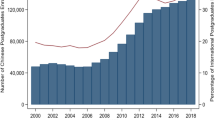Abstract
Global flows of students in higher education are growing at an unprecedented pace and sustained scale. This has far-reaching economic and academic implications for sending and receiving countries, institutions and students themselves. China is one of the largest countries which actively engages in both sending students abroad and receiving international students from all over of the world. As an emerging economic and political force in the new century, China is moving increasingly from a peripheral position to a more central one in the global network of international student mobility. This chapter first introduces theories of international student mobility. It then portrays the historical trajectory of China’s sending students abroad and attracting international students since the open door policy began in 1978. Between 1978 and 2005, the total number of international students studying in China was an estimated 871,000, while 933,000 Chinese studied abroad. The chapter compares the development characteristics of international students in China with that of Chinese students abroad, by main destination and source countries, the level of study, the field of subjects, the financial sources and so on. Having been one of the largest exporters and a modest importer of students for several decades, in a globalizing era China is now witnessing a more balanced development with two-way flows of students. Influxes and outflows of students are influenced by geopolitical, economic, social and cultural elements. The chapter briefly compares the similarities and differences of features of the two groups of students, and analyses the problems and prospects of two-way flows.
Access this chapter
Tax calculation will be finalised at checkout
Purchases are for personal use only
Similar content being viewed by others
Notes
- 1.
. 1.00 U.S. Dollar = 8.275 Yuan RMB.
References
Altbach, P. G. (1998). The foreign student dilemma. In P. G. Altbach (Ed.), Comparative higher education: Knowledge, the university, and development, pp. 225–246. Hong Kong: Comparative Education Research Centre, The University of Hong Kong.
Altbach, P. G. (2004). Globalization and the universities: Myths and realities in an unequal world. Tertiary Education and Management, 10(1), 3–60.
Chen, T. M., & Barnett, G. A. (2000). Research on international student flows from a macro perspective: A network analysis of 1985, 1989 and 1995. Higher Education, 39(4), 435–453.
Chow, P., & Marcus, R. (2007). International student mobility and the United States: The 2007 Open Doors Survey. International Higher Education, 50, 13–14.
Government of China. (1988–2007). China education yearbook: 1987-2006 [Zhongguo Jiaoyu Nianjian: 1987-2006]. Beijing: People’s Education Press.
IIE (2006). Open doors 2006: Report on international educational exchange. Retrieved July 4, 2008 from: http://opendoors.iienetwork.org/.
Ji, M. M. (Ed.). (1997). Encyclopaedia of Chinese education administration, pp. 1577 & 1592. In Chinese. [Zhongguo Jiaoyu Xingzheng Quanshu]. Beijing: Economic Daily Press.
Li, M., & Bray, M. (2006). Social class and cross-border higher education: Mainland Chinese students in Hong Kong and Macau. Journal of International Migration and Integration, 7(4), 407–424.
Marginson, S. (2006). Dynamics of national and global competition in higher education. Higher Education, 52, 1–39.
Mazzarol, T., & Soutar, G. N. (2001). The global market for higher education: Sustainable competitive strategies for the new millennium. Cheltenham: Edward Elgar.
Ministry of Education. (2005). 2004 laihua liuxuesheng tongji shuju (2004 statistics on international students in China). http://www.csc.edu.cn/gb/downloaddoc/2004lhtj.doc. Accessed 22 August 2006.
Ministry of Education. (2006). 2005 laihua liuxuesheng tongji shuju (2005 statistics on international students in China). http://www.edu.cn/20060605/3193434.shtml. Accessed 8 June 2006.
Ministry of Education. (2007). 2006 laihua liuxuesheng tongji shuju (2006 statistics on international students in China). http://www.csc.edu.cn/gb/readarticle/readarticle.asp?articleid =2556. Accessed 25 August 2007.
UNESCO UIS (Institute for Statistics) database. (2006). Student on the move, the future of international students in the United States. http://www.acenet.edu/AM/Template.cfm?Section=Home&CONTENTID = 18582&TEMPLATE=/CM/ContentDisplay.cfm. Accessed 4 July 2008.
Verbik, L., & Lasanowski, V. (2007). International student mobility: Patterns and trends. London: The Observatory on Borderless Higher Education.
Welch, A., & Zhang, Z. (2008). The Chinese knowledge diaspora: Communication networks among overseas Chinese intellectuals. In R. Boden, R. Deem, D. Epstein, and F. Rizvi (Eds.), Geographies of knowledge, geometries of power: Higher education in the 21st century. World Yearbook of Education 2008. (pp. 339–354) London: Routledge.
Zhang, J. (1984). China education yearbook: 1949-1981(in Chinese). Beijing: China Encyclopedia Press.
Zheng, X. H. (2003). An analysis on study abroad of graduates of undergraduate in Qinghua University. In L. Tian (Ed.), Research on China’s foreign cultural exchange in higher education (pp. 199–237). In Chinese. Beijing: Minzu Press.
Zweig, D., & Fung, C. S. (2004). Redefining the brain drain: China’s diaspora option. Centre on China’s Transnational Relations, Hong Kong University of Science and Technology, working paper no. 1. http://www.cctr.ust.hk/articles/pdf/redefining.pdf. Accessed 19 April 2005.
Author information
Authors and Affiliations
Corresponding author
Editor information
Editors and Affiliations
Rights and permissions
Copyright information
© 2011 Springer Science+Business Media B.V.
About this chapter
Cite this chapter
Li, M., Zhang, Y. (2011). Two-Way Flows of Higher Education Students in Mainland China in a Global Market: Trends, Characteristics and Problems. In: Marginson, S., Kaur, S., Sawir, E. (eds) Higher Education in the Asia-Pacific. Higher Education Dynamics, vol 36. Springer, Dordrecht. https://doi.org/10.1007/978-94-007-1500-4_16
Download citation
DOI: https://doi.org/10.1007/978-94-007-1500-4_16
Published:
Publisher Name: Springer, Dordrecht
Print ISBN: 978-94-007-1499-1
Online ISBN: 978-94-007-1500-4
eBook Packages: Humanities, Social Sciences and LawEducation (R0)




